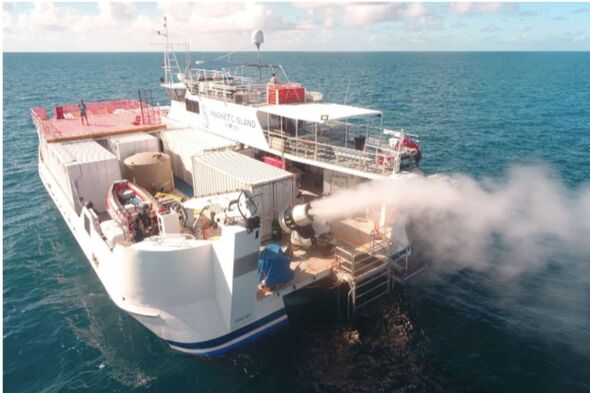
UPDATE: A controversial geoengineering experiment aimed at altering weather patterns over the San Francisco Bay was abruptly halted by city officials last year, raising urgent questions about transparency and accountability in climate intervention efforts. New documents obtained by Politico reveal that a team from the University of Washington sought to use a retired aircraft carrier to deploy saltwater-spraying machinery over an area larger than Puerto Rico.
The pilot initiative, conducted in Alameda for just 20 minutes, was cut short after local authorities claimed they were not informed about the operation. The multi-million dollar project, which aimed to assess whether cloud-manufacturing instruments could effectively influence the climate, has sparked significant debate regarding the ethics and potential consequences of such interventions.
Researchers intended to blanket large ocean areas with man-made clouds as part of a broader strategy to combat climate change, but city officials’ swift intervention underscores the challenges facing solar geoengineering initiatives amid heightened political scrutiny. The experiment was projected to cost between $10 million and $20 million and was expected to expand to regions including Chile and south-central Africa.
Why this matters NOW: As climate change accelerates, the urgency surrounding innovative solutions like solar geoengineering intensifies. However, the backlash against such methods is mounting, with critics warning that they could disrupt weather patterns and agricultural systems. Recent political actions, including a proposed bill from Rep. Marjorie Taylor Greene to criminalize the technology, reflect a growing concern among lawmakers regarding the potential for weather manipulation.
In response to these developments, Sarah Doherty, who leads the Marine Cloud Brightening Program, stated, “The program does not ‘recommend, support or develop plans for the use of marine cloud brightening to alter weather or climate.’” This statement highlights the complicated nature of the research, which is often shrouded in secrecy and skepticism from both the scientific community and the public.
The documents reveal that the project was backed by a group of billionaires, including cryptocurrency mogul Chris Larsen and philanthropist Rachel Pritzker. Larsen emphasized the need for continued research, stating, “At a time when scientists are facing political attacks and drastic funding cuts, we need to complement a rapid energy transition with more research into a broad range of potential climate solutions.”
However, opposition is fierce. More than 575 scientists have called for an outright ban on geoengineering development, arguing that it cannot be governed globally in a fair and effective manner. Critics warn that solar geoengineering could exacerbate existing inequalities and environmental issues, and some lawmakers are taking action to prevent its implementation altogether. Florida Governor Ron DeSantis recently signed a law prohibiting the release of chemicals into the atmosphere for climate modification.
As the political landscape shifts, the future of geoengineering remains uncertain. The initial experiment’s failure has raised critical questions about the feasibility and public acceptance of such drastic measures in the fight against climate change.
What’s next? The scientific community and policymakers will need to navigate the complex landscape of public trust, ethical considerations, and environmental impact as they confront the pressing realities of climate change. The conversation around geoengineering is far from over, and further developments are expected in the coming months.
For now, all eyes are on the University of Washington and its partners as they reassess the future of their ambitious climate intervention plans.





